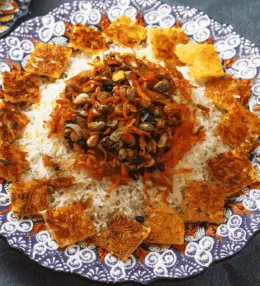
- View
Table of Contents
TogglePecel is a dish that captures the heart of Javanese home cooking. It is a vibrant salad of blanched vegetables generously covered in warm peanut sauce, served daily across Central and East Java. For many Indonesians, pecel offers comfort, simplicity, and a sense of place with every spoonful.
This dish is not just about nourishment but connection. It links the land, farmers, and cooks in a chain of care that ends on your plate. With its earthy, nutty flavours balanced by hints of sweetness and spice, pecel brings together the essence of Javanese food philosophy in a single dish.
Want to dive deeper into Indonesian Cuisine? Don’t miss our post on 31 Traditional Indonesian Foods to Try
What Is Pecel?
Pecel is a vegetable salad served with a thick peanut sauce dressing. Unlike Western salads served cold with oil based dressings, pecel is often enjoyed warm, allowing the peanut sauce to coat each vegetable fully.
The vegetables are lightly blanched to maintain freshness and crunch. Common additions include water spinach, bean sprouts, long beans, cabbage, and cucumber. Some people add steamed rice cakes or fried tempeh alongside to create a fuller meal.
Pecel is eaten throughout the day, whether for breakfast with rice and crackers, or as a light lunch. Its adaptability and low cost have made it beloved among students, workers, and anyone seeking a quick but satisfying meal that feels homemade.
Ingredients and Taste
The peanut sauce is what defines pecel. Made from roasted peanuts ground to a thick paste, it is combined with garlic, chillies, tamarind, palm sugar, and a touch of lime leaf or kaffir lime juice for aroma. Salt and shrimp paste are sometimes added to deepen flavour.
This sauce is poured over freshly blanched greens, creating a dish that is creamy and crunchy at once. The taste is complex, dominated by the rich earthiness of peanuts, mellowed by sweetness from palm sugar, with gentle heat from red chillies.
The vegetables themselves bring their own flavours, from the mild bitterness of water spinach to the freshness of cucumber. Together, each bite offers a harmony of textures and tastes, with the sauce tying everything together into a hearty, balanced dish.
A Taste of History
Pecel’s roots lie in rural Java where vegetables are abundant and accessible. It is believed to have existed for centuries as a farmer’s meal, where freshly harvested greens were quickly blanched and dressed with peanut sauce made from local peanuts.
Over time, pecel spread across regions, adapting to local ingredients and preferences. In East Java, pecel sauce tends to be spicier and thicker, while in Central Java, it is slightly sweeter. Each village and family has its own recipe, passed down through generations.
Today, pecel remains a testament to Javanese culinary traditions that value balance and simplicity. It is served in street stalls, warungs, and homes alike, reflecting a way of life that respects the land and celebrates modest yet bold flavours. Pecel offers more than sustenance. It tells the story of Java’s agricultural heart, its resourceful cooks, and its love of meals that comfort the body while nourishing the spirit.
How to make Pecel
Pecel is a vibrant Javanese salad bathed in earthy peanut sauce, offering crunch from lightly blanched vegetables and aromatic depth from its chilli infused dressing. Expect a straightforward process with simple blanching, blending, and assembly. Prepare all vegetables before starting to create an efficient flow. See the recipe card at the bottom for printable directions
Ingredients
For the Salad
- 200g water spinach (kangkung), cut into 5cm lengths
- 150g bean sprouts, rinsed and cleaned
- 200g cabbage, roughly shredded
- 100g long beans, cut into 5cm lengths
- 1 small cucumber, thinly sliced
For the Peanut Sauce
- 200g roasted peanuts, unsalted
- 4 red chillies (adjust to taste), deseeded for milder sauce
- 3 cloves garlic, peeled
- 1 piece kencur (lesser galangal), around 2cm, peeled (optional but traditional)
- 2 tablespoons coconut sugar, grated
- 1 teaspoon salt
- Juice of 1 lime
- 150ml warm water (adjust for desired consistency)
- 2 kaffir lime leaves, finely sliced (optional for aroma)
Cooking Instructions
Step 1: Prepare the Vegetables
To begin, bring a large pot of water to a boil. Blanch the water spinach for 30 seconds until bright green. Remove and immediately place into a bowl of iced water to retain colour and crispness. Drain well and set aside for assembly.
Step 2: Blanch the Remaining Vegetables
Next, blanch the bean sprouts for 20 seconds, then transfer to iced water. Repeat the same process for cabbage and long beans, blanching each for about 1 minute until just tender yet crunchy. Drain all vegetables thoroughly before arranging.
Step 3: Toast the Peanuts
In a dry pan over medium heat, lightly toast the roasted peanuts for 2 minutes to release their oils and deepen flavour. Stir constantly to avoid burning. Remove and let them cool slightly before blending.
Step 4: Blend the Peanut Sauce
Using a food processor or traditional pestle and mortar, blend toasted peanuts, red chillies, garlic, kencur, coconut sugar, and salt until a coarse paste forms. Traditional pestle and mortar enhance flavour but require more time and patience.
Step 5: Adjust the Sauce Consistency
Pour in warm water gradually while blending to achieve a thick yet pourable sauce. Add lime juice and kaffir lime leaves, blending briefly to incorporate without losing fresh citrus aromas. Taste and adjust seasoning if needed.
Step 6: Arrange the Salad Base
On a large serving platter, neatly arrange blanched water spinach, bean sprouts, cabbage, long beans, and cucumber slices in separate sections for an attractive presentation.
Step 7: Pour Over the Peanut Sauce
Generously pour the peanut sauce over the arranged vegetables, ensuring each type gets coated lightly while keeping the presentation colourful and distinct.
Step 8: Prepare Optional Condiments
If desired, prepare additional sides like steamed rice cakes (lontong) cut into bite sized cubes or krupuk (Indonesian crackers) for extra crunch alongside the salad.
Step 9: Garnish for Aroma and Colour
Sprinkle extra kaffir lime leaves or thinly sliced chillies on top for an added burst of colour and fragrance before serving to guests.
Final Step: Serve the Pecel
To conclude, serve Pecel at room temperature with warm rice cakes and crackers on the side. This dish is best enjoyed immediately to retain the vegetables’ crispness and the sauce’s aromatic freshness.
Variations and Substitutions
- Replace galangal with ginger if unavailable, though traditional flavour will slightly differ.
- Add blanched kangkung (water spinach) for a more authentic Javanese touch.
- For vegan sweetness, ensure your palm sugar is pure and not blended with honey.
Cooking Tips for Perfect Pecel
- Always use roasted peanuts for authentic depth; raw peanuts lack the earthy richness traditional Pecel demands.
- Blanch vegetables briefly to keep their crunch; overcooked vegetables yield a limp salad.
- Adjust the number of chillies to your heat preference; Pecel is traditionally mildly spicy.
- If kencur is unavailable, omit it, but it adds a distinct earthy aroma if included.
- Prepare the sauce just before serving to maintain its bright flavours and aroma.

Pecel (Javanese Salad with Peanut Sauce)
Ingredients
For the Salad
- 200 g water spinach kangkung, cut into 5cm lengths
- 150 g bean sprouts rinsed and cleaned
- 200 g cabbage roughly shredded
- 100 g long beans cut into 5cm lengths
- 1 small cucumber thinly sliced
For the Peanut Sauce
- 200 g roasted peanuts unsalted
- 4 red chillies adjust to taste, deseeded for milder sauce
- 3 cloves garlic peeled
- 1 piece kencur lesser galangal, around 2cm, peeled (optional but traditional)
- 2 tablespoons coconut sugar grated
- 1 teaspoon salt
- Juice of 1 lime
- 150 ml warm water adjust for desired consistency
- 2 kaffir lime leaves finely sliced (optional for aroma)
Instructions
- To begin, bring a large pot of water to a boil. Blanch the water spinach for 30 seconds until bright green. Remove and immediately place into a bowl of iced water to retain colour and crispness. Drain well and set aside for assembly.
- Next, blanch the bean sprouts for 20 seconds, then transfer to iced water. Repeat the same process for cabbage and long beans, blanching each for about 1 minute until just tender yet crunchy. Drain all vegetables thoroughly before arranging.
- In a dry pan over medium heat, lightly toast the roasted peanuts for 2 minutes to release their oils and deepen flavour. Stir constantly to avoid burning. Remove and let them cool slightly before blending.
- Using a food processor or traditional pestle and mortar, blend toasted peanuts, red chillies, garlic, kencur, coconut sugar, and salt until a coarse paste forms. Traditional pestle and mortar enhance flavour but require more time and patience.
- Pour in warm water gradually while blending to achieve a thick yet pourable sauce. Add lime juice and kaffir lime leaves, blending briefly to incorporate without losing fresh citrus aromas. Taste and adjust seasoning if needed.
- On a large serving platter, neatly arrange blanched water spinach, bean sprouts, cabbage, long beans, and cucumber slices in separate sections for an attractive presentation.
- Generously pour the peanut sauce over the arranged vegetables, ensuring each type gets coated lightly while keeping the presentation colourful and distinct.
- If desired, prepare additional sides like steamed rice cakes (lontong) cut into bite sized cubes or krupuk (Indonesian crackers) for extra crunch alongside the salad.
- Sprinkle extra kaffir lime leaves or thinly sliced chillies on top for an added burst of colour and fragrance before serving to guests.
- To conclude, serve Pecel at room temperature with warm rice cakes and crackers on the side. This dish is best enjoyed immediately to retain the vegetables’ crispness and the sauce’s aromatic freshness.
Nutrition
You May Also Like







Leave a Review